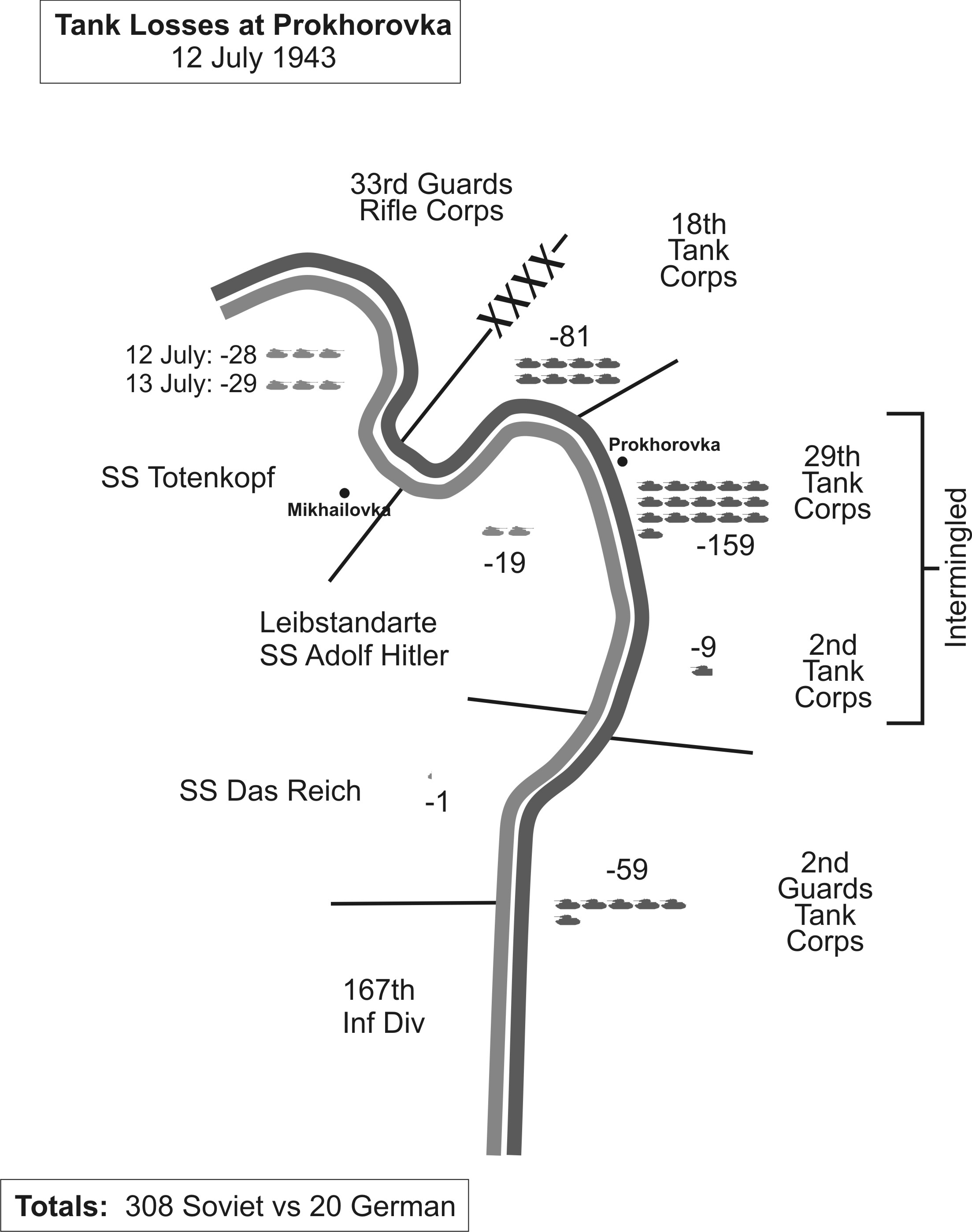
If one looks at the losses in the above graphics, one sees the Totenkopf SS Panzer Grenadier Division loosing 28 tanks on the 12th and 29 tanks on the 13th. This is merely a straight line estimate of the losses over two days, as we do not know what they lost on the 12th. We know what they report ready for action on the 11th and we know what they report ready for action on the 13th.
Totenkopf had as of the evening of 11July the following tanks (source: TDI’s Kursk Data Base):
Pz III Long: 54
Pz III Observation: 5
Pz III Command: 7
Pz IV short: 4
Pz IV long: 26
Pz VI: 10 *
Pz VI Command: 1
StuG III: 21
Marder II: 11
On the 13th we have them with:
Pz III long: 32
Pz III Observation: 5
Pz Command: 5
Pz IV short: 3
Pz IV long: 14
Pz VI: 0
Pz VI Command: 1
StuG III: 20
Marder II: 2
This is decline of 57 tanks.
There was a status report for Totenkopf on the 12th but it indicates no losses for the 12th of July (and includes one additional Tiger). Considering its operations that day (read pages 924-927 of my Kursk book or 307-312 of my Prokhorovka book), that is hard to believe. For in addition to being engaged with the gutted 52nd Guards Rifle Division and the fresh 95th Guards Rifle Division of the Fifth Guards Army, they were also engaged with the 11th Motorized Rifle Brigade (X Guards Tank Corps), the 99th Tank Brigade (II Tank Corps) and to some extent with the 181st Tank Brigade (XVIII Tank Corps). Furthermore, they conducted offensive operations: at 0715 (Berlin time) taking the barracks (at Kluchi?) with their panzer battalion, and then their armored group at 0930 (Berlin time) jumped off from hill 226.6 to the northeast. The Fifth Guards Army confirms that the Germans launched this attack claiming at 1215 (Moscow time) the Germans attacked with 100 tanks in the direction of height 226.6. This attack was successful and pushed on to the eastern outskirts of Veselyii and height 236.7.
The Soviets throughout the day launched multiple attacks against the division also. Totenkopf reports attacks on the barracks northwest of Klyuchi at 0330 and 0730. The second attack had tank support (we think from the 99th Tank Brigade, II Tank Corps). There were also many other Soviet attacks during the day.
And then, at 1115 (Berlin time) Totenkopf diverted its drive to the northeast to turn its armor south to cross the Psel at Mikhailovka and move in behind the Soviets south of the Psel. Part of Totenkopf’s armor did cross to the south of the Psel this day and got into a heavy exchange with the XVIII Tank Corps.
It is hard to say what was where at this time, but Totenkopf continued to also advance north of the Psel to the northeast. At 1500 (Berlin time) the Totenkopf armored group was two kilometers northwest of Polezhayev. At 1630 (Moscow time), the Soviets reported that the German offensive had been halted, but fighting clearly continued, for at 1835 (Berlin time), the SS Panzer Corps reported that the armored group from Totenkopf were engaged in heavy tank battles around one kilometer northwest of Polezhayev. Worth looking at a map for this, but Polozhayev is north of Prokhorovka.
There is also the claim in Soviet records that at 1600 (Moscow time) 36 German tanks from hill 226.6 descended into the depression north of that hill and moved through the ravine west of Polezhayev, and headed towards hill 236.7 (some four kilometers away). Reaching the hill, the tanks spent an hour driving back and forth on it, and then departed into the depression west of hill 236.7 (see Prokhorovka, page 309).
Hard to believe that the Totenkopf SS Division suffered no armor losses on the 12th, not even a tank or two broken down. Hard to move armor around without a few breakdowns. Yet, Totenkopf has a tank status report for the 12th that shows no losses. We do not believe that this report reflects the actual situation as of the end of the day on the 12th.
So, we were left with assuming that there were no armor losses on the 12th and 57 tanks lost on the 13th…..or we could split them evenly between the two days. We did the latter, as that appeared more rational. Considering the offensive operations conducted by the Totenkopf SS Division on the 13th and that they were then driven back (!), one could certainly make the argument that more losses should have been assigned on the 13th than the 12th (see pages 965-969 of my Kursk book or 359-363 of my Prokhorovka book). Still, hard to believe there were no losses on the 12th.
It also opens up the question of how many of the XVIII Tank Corps losses were due to the actions of the Totenkopf SS Division and how many tanks did Totenkopf loose engaging the XVIII Tank Corps. The record is not clear here.
* They had either 9 Pz VIs this day or 10, depending on which report you choose to accept (see page 926-927 or 311-312)
